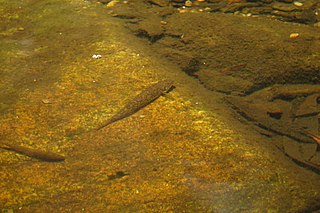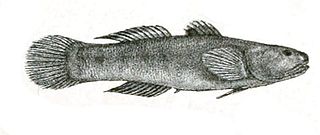
The Chao Phraya River is the major river in Thailand, with its low alluvial plain forming the centre of the country. It flows through Bangkok and then into the Gulf of Thailand.

Rambai Barni, formerly Rambai Barni Svastivatana, was Queen of Siam as the wife of King Prajadhipok of Siam.

Lake Towuti is a lake in East Luwu Regency, South Sulawesi province, Indonesia. Surrounded by mountains, it is the largest lake of the island of Sulawesi and one of the five lakes of the Malili Lake system. The Larona River flows from the lake to the Boni Bay. The town Laronda is located on its shore.
Mugilogobius adeia is a species of goby endemic to Lake Matano on the Indonesian island of Sulawesi where it inhabits areas with a number of shells of the gastropod Tylomelania gemmifera in which it seeks shelter. This species can reach a length of 4.3 centimetres (1.7 in) TL.

Mugilogobius is a genus of fish in the family Gobiidae. They are found in fresh, brackish and marine water of the Indo-Pacific region. Several of the freshwater species have highly restricted distributions.

Awaous acritosus, the Roman nose goby, is a species of goby that is native to fresh water rivers and streams of Queensland, Australia and the Laloki River drainage of New Guinea.
Awaous grammepomus, the Scribbled goby, is a species of goby native to freshwater streams and rivers and brackish estuaries from Sri Lanka to New Guinea with a report of it occurring in Palau. This species can reach a length of 15 centimetres (5.9 in) SL. It is of minor importance to local commercial fisheries and can also be found in the aquarium trade.

Oxyurichthys microlepis, commonly known as the maned goby, is a species of goby native to tropical marine and brackish waters along the coasts of the Indian Ocean from Africa to the western Pacific Ocean where it occurs in estuaries and inshore waters to depths of about 75 metres (246 ft). It occurs in the Mekong Delta and is suspected to use the tidal flow up the river to reach as far inland as Cambodia. This species can reach a length of 13.5 centimetres (5.3 in) TL. It is of minor importance to local commercial fisheries and can also be found in the aquarium trade.

The Gobionellinae are a subfamily of fish which was formerly classified in the family Gobiidae, the gobies, but the 5th Edition of Fishes of the World classifies the subfamily as part of the family Oxudercidae. Members of Gobionellinae mostly inhabit estuarine and freshwater habitats; the main exception is the genus Gnatholepis, which live with corals in marine environments. The subfamily is distributed in tropical and temperate regions around the world with the exception of the northeastern Atlantic Ocean, the Mediterranean Sea, and the Ponto-Caspian region. It includes around 370 species and 55 genera: Wikipedia articles about genera list about 389 species.
Akihito vanuatu, the Vanuatu's emperor, is a species of fish in the family Oxudercidae, the gobies. It is endemic to Vanuatu, where it inhabits streams and pools. Males of this species can reach a length of 4.3 centimetres (1.7 in) SL while females can reach 3.9 centimetres (1.5 in) SL.

Pseudogobius is a genus of fish in the goby family, Gobiidae. It is widely distributed in tropical and temperate regions of the Indian and western Pacific Oceans. Species occur in freshwater and estuarine habitat types, such as mangroves and seagrass beds.

Drombus globiceps is one of ten species of goby in the genus Drombus. It is found in the western Indo-Pacific. Its common names include Kranji drombus and bighead goby. It is a tropical fish and has been recorded from the Ganges Delta and Chilika Lake of India, the Bay of Bengal, Thailand, Singapore, Indonesia, Papua New Guinea, and the Northern Territory and northern Queensland of Australia. It lives in both marine and fresh water environments. It is considered that D. globiceps is possibly a synonym of Drombus ocyurus. Its conservation threat is categorised as least concern by the IUCN.
Mugilogobius chulae, commonly known as the yellowstripe goby or Chulae's goby, is a species of freshwater, brackish goby, where it feeds on small crustaceans, aquatic insects and insect larvae. It is found in coastal eastern Asia from the Ryukyu Islands south to Sumatra.
Awaous melanocephalus, the largesnout goby, is a species of goby that is native to fresh water rivers and streams of India, Sri Lanka, Ryukyu Islands, China, Taiwan, Vietnam, Thailand, Philippines, Indonesia, Papua New Guinea and Solomon Islands. Some suggestions has been recorded from Fiji islands and Mauritius, but not confirmed yet.

Mugilogobius platynotus, commonly known as the flatback mangrove goby, is a species of goby native to eastern Australia.

Mugilogobius stigmaticus, commonly known as blackspot mangrove goby, is a species of goby native to the waters of eastern Australia.
Papuligobius uniporus is a species of small goby in the subfamily Gobionellinae. It is also the type species of the genus Papuligobius.

Goby is a common name for many species of small to medium sized ray-finned fish, normally with large heads and tapered bodies, which are found in marine, brackish and freshwater environments.
Helen K. Larson is an ichthyologist who specialises in the fishes of the Indo-Pacific.













